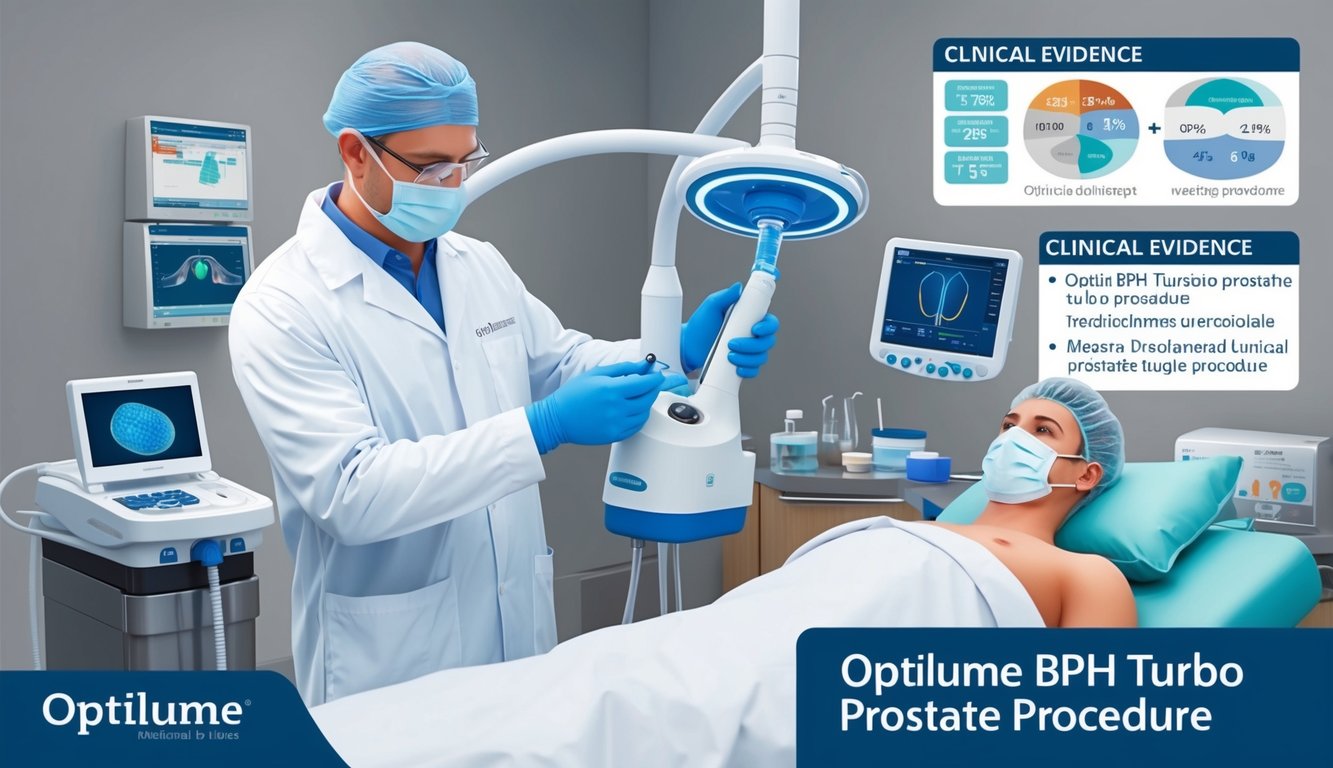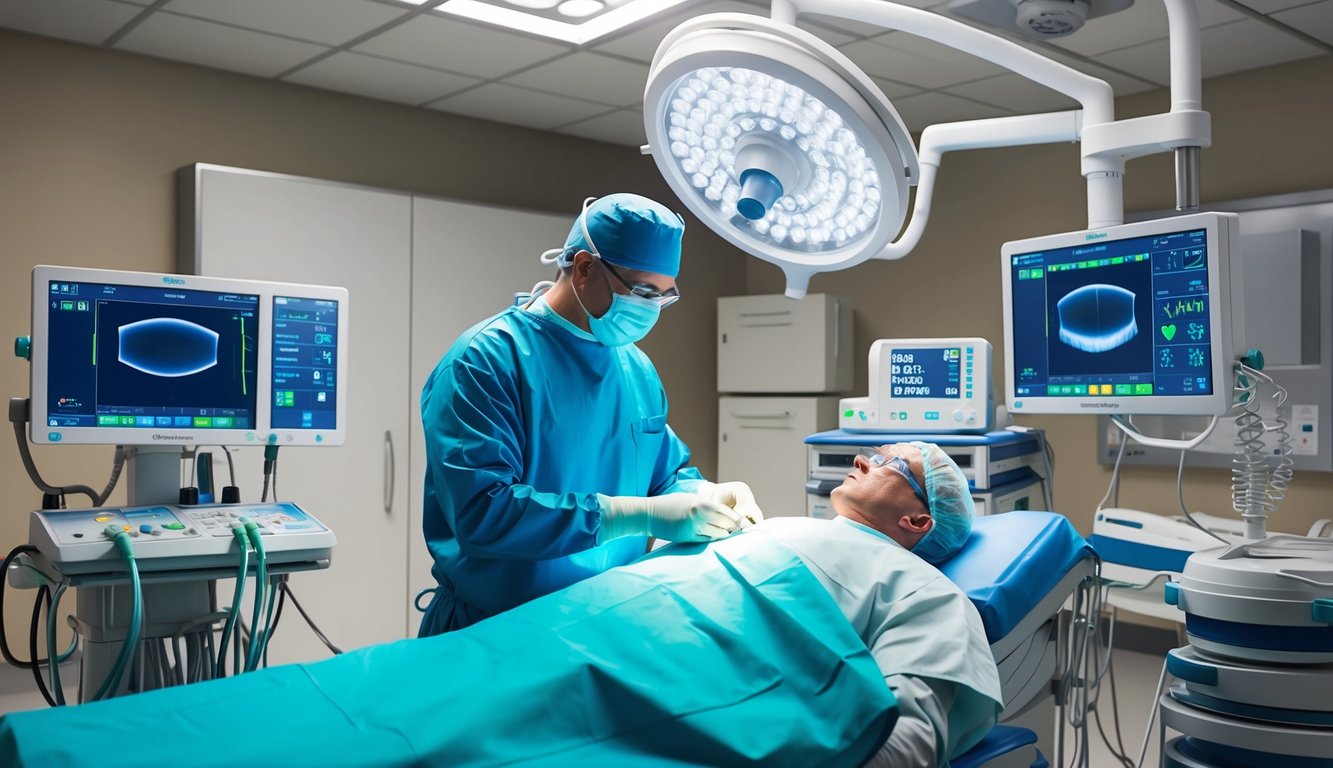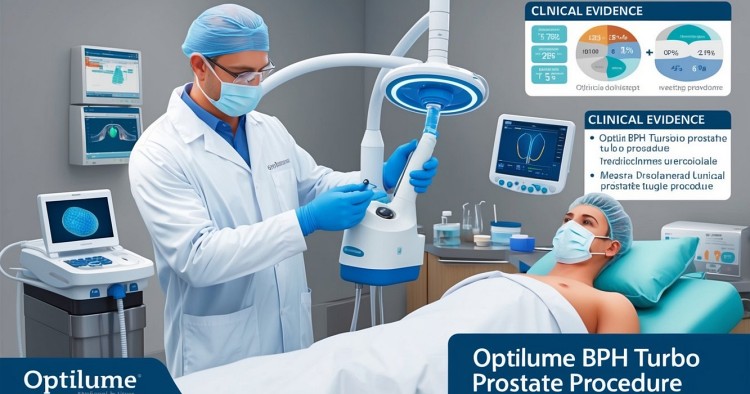Optilume BPH TURBO (Trans-Urethral Radial-dilation Balloon Opening) Prostate Procedure, a Revolutionary BPH Treatment: Advancing Minimally Invasive Urological Care
Benign Prostatic Hyperplasia (BPH) affects millions of men worldwide, causing uncomfortable urinary symptoms and impacting quality of life. Traditional treatments often involve invasive surgeries or long-term medication use. However, a groundbreaking minimally invasive procedure is changing the landscape of BPH management.
The Optilume BPH TURBO is an innovative treatment that combines balloon dilation with drug-coated technology to address BPH symptoms effectively. This FDA-approved therapy offers a minimally invasive alternative to traditional surgical interventions, promising faster recovery times and fewer complications.
Clinical trials have demonstrated the effectiveness of the Optilume BPH TURBO, with positive outcomes observed up to five years post-treatment. The procedure’s unique approach targets urinary obstruction while potentially reducing the regrowth of prostate tissue, offering hope for long-term symptom relief.
Key Takeaways
- Optilume BPH TURBO is a minimally invasive treatment for BPH symptoms.
- The procedure combines balloon dilation with drug-coated technology for effective results.
- Clinical evidence supports Optilume’s effectiveness for up to five years post-treatment.
Understanding Benign Prostatic Hyperplasia (BPH)
Benign Prostatic Hyperplasia (BPH) is a common condition affecting older men. It involves enlargement of the prostate gland, leading to urinary symptoms and potential impacts on quality of life.
The Prostate and BPH
The prostate is a small gland located below the bladder in men. It surrounds the urethra, the tube that carries urine from the bladder out of the body. As men age, the prostate often enlarges, a condition known as BPH.
BPH is not cancerous, but it can cause significant urinary issues. The enlarged prostate can compress the urethra, making it difficult for urine to flow freely. This enlargement typically begins around age 40 and becomes more common as men get older.
Risk factors for BPH include age, family history, and certain medical conditions like obesity and diabetes.
Symptoms of BPH
BPH causes a range of Lower Urinary Tract Symptoms (LUTS). These symptoms can vary in severity and may include:
- Frequent urination, especially at night
- Difficulty starting urination
- Weak urine stream
- Inability to completely empty the bladder
- Urgent need to urinate
- Dribbling at the end of urination
Doctors often use the International Prostate Symptom Score (IPSS) to assess symptom severity. This standardized questionnaire helps quantify the impact of BPH on a patient’s urinary function.
Impact on Quality of Life
BPH can significantly affect a man’s quality of life. The frequent need to urinate can disrupt sleep, leading to fatigue and irritability. Some men may avoid social situations due to concerns about sudden urges to urinate.
The old adage – “Never pass a bathroom when one is available” comes to mind and I can tell you from experience you learn to notice bathrooms and use them frequently – just in case.
The condition can also cause anxiety about urinary accidents or the inability to find a bathroom quickly. In severe cases, BPH can lead to complications such as urinary tract infections, bladder stones, or kidney damage if left untreated.
Many men with BPH experience a decrease in sexual function, which can strain relationships and impact self-esteem. Effective treatment of BPH often leads to improved sexual function and overall quality of life.
The Optilume BPH TURBO Procedure
The Optilume BPH TURBO procedure offers a novel approach to treating benign prostatic hyperplasia (BPH). This minimally invasive treatment uses a drug-coated balloon to reshape the prostatic urethra, improving urine flow.
Innovative Approach to BPH Treatment
The Optilume BPH Catheter System represents a significant advancement in BPH treatment. It combines mechanical dilation with drug delivery, targeting the root cause of urinary symptoms.
Unlike traditional surgical methods, this procedure doesn’t remove prostate tissue. Instead, it utilizes a balloon catheter coated with paclitaxel, a medication that inhibits cell growth.
The system is designed to be less invasive than conventional surgeries, potentially offering quicker recovery times and reduced risk of complications.
The Mechanism of Action
The Optilume BPH TURBO procedure works through a dual mechanism:
- Mechanical dilation: The balloon expands to reshape the prostatic urethra.
- Drug delivery: Paclitaxel is applied directly to the treated area.
This combination approach aims to create a wider urethral passage while preventing tissue regrowth. The paclitaxel coating helps maintain the effects of the dilation over time.
The procedure targets the anterior portion of the prostate, creating what’s known as an anterior commissurotomy. This strategic approach aims to maximize symptom relief while minimizing potential side effects.
Procedure and Recovery
The Optilume BPH TURBO procedure is typically performed as an outpatient treatment. It usually takes about 10 minutes to complete.
A urologist inserts the catheter through the urethra using a cystoscope for guidance. Once positioned, the balloon is inflated to reshape the prostatic urethra.
Patients often receive local anesthesia and may undergo spinal block. This approach allows for quicker recovery compared to general anesthesia.
Most individuals can return home the same day. Recovery time is generally shorter than with traditional surgical interventions. Patients may experience mild discomfort or urinary symptoms for a few days post-procedure.
Clinical Evidence Supporting Optilume BPH Treatment

The Optilume BPH treatment has shown promising results in clinical trials. Research demonstrates improvements in urinary symptoms and flow rates, with minimal side effects reported.
Pinnacle Study Overview
The PINNACLE Study was a double-blind, randomized, sham-controlled trial evaluating the Optilume BPH Catheter System. This study involved patients with symptomatic benign prostatic hyperplasia (BPH).
The trial design included a treatment group receiving the Optilume procedure and a control group undergoing a sham procedure. This approach allowed for a direct comparison of outcomes between the two groups.
Researchers assessed changes in urinary symptoms, flow rates, and quality of life measures. The study duration provided insights into both short-term and longer-term effects of the treatment.
Safety and Effectiveness
The Optilume BPH treatment demonstrated significant improvements in urinary symptoms and flow rates. Patients experienced rapid symptom relief, with benefits sustained over time.
Key findings include:
- Improved urinary flow rates
- Reduced lower urinary tract symptoms (LUTS)
- Preserved erectile and ejaculatory function
The procedure was well-tolerated, with minimal adverse events reported. Most side effects were mild and resolved quickly without intervention.
Long-term follow-up studies have shown durable results, with benefits maintained for up to two years post-treatment.
Comparison with Other Treatments
Optilume BPH offers several advantages compared to traditional BPH treatments:
- Minimally invasive approach
- Office-based or ambulatory setting
- Rapid recovery time
Unlike medications, Optilume provides immediate symptom relief. It also avoids the potential side effects associated with long-term drug use.
Compared to surgical options like TURP, Optilume is less invasive and has a lower risk of complications. The preservation of sexual function is a notable benefit.
The procedure combines mechanical dilation with drug delivery, potentially offering more lasting results than other minimally invasive options.
The Benefits of Minimally Invasive Surgical Therapy

Minimally invasive surgical therapy offers significant advantages for patients with benign prostatic hyperplasia (BPH). These procedures provide effective symptom relief while minimizing risks and side effects associated with traditional surgeries.
Comparing MIST with Traditional Procedures
Minimally invasive surgical therapies (MIST) for BPH, such as the Optilume BPH TURBO Treatment System, offer several benefits over traditional surgical approaches. MIST procedures are typically performed in an office setting under local anesthesia, reducing the need for hospitalization and general anesthesia.
The recovery time for MIST is significantly shorter compared to traditional surgeries. Patients often experience less pain and can return to normal activities more quickly. MIST procedures also carry a lower risk of complications such as bleeding and infection.
Traditional surgeries like transurethral resection of the prostate (TURP) may require longer hospital stays and have higher risks of side effects. MIST options provide a middle ground between medication and invasive surgery, offering effective symptom relief with fewer drawbacks.
Impact on Sexual Function and Continence
One of the key advantages of MIST procedures is their potential to preserve sexual function while improving urinary symptoms. Many men undergoing traditional BPH surgeries experience issues with erectile or ejaculatory function.
MIST options like the Optilume system have shown promising results in maintaining sexual function. Studies have reported low rates of erectile dysfunction and retrograde ejaculation following these procedures.
Urinary continence is another important factor. MIST procedures generally have a lower risk of causing stress urinary incontinence compared to more invasive surgeries. This helps preserve quality of life and reduces the need for additional treatments or interventions.
Expected Outcomes and Quality of Life Measures
Patients undergoing MIST for BPH can expect significant improvements in their urinary symptoms and overall quality of life. The Optilume BPH Catheter System has demonstrated immediate and durable symptom relief in clinical studies.
Key outcome measures include:
- Improved urinary flow rate
- Reduced post-void residual urine volume
- Decreased nocturia (nighttime urination)
- Lower International Prostate Symptom Score (IPSS)
- Better quality of life
Quality of life improvements are often substantial. Many patients report better sleep, increased ability to engage in social activities, and reduced anxiety related to urinary symptoms.
Long-term data now extends up to 5 years for some MIST procedures, showing sustained benefits. This durability of results is crucial for patient satisfaction and reducing the need for repeat treatments.
Considering Optilume BPH Procedure: A Patient’s Guide

The Optilume BPH procedure offers a minimally invasive option for treating benign prostatic hyperplasia (BPH). Patients considering this treatment should understand the key aspects of eligibility, preparation, and post-procedure care.
When to Consider Optilume
Patients with moderate to severe lower urinary tract symptoms (LUTS) due to BPH may be candidates for the Optilume procedure. A urologist will evaluate symptoms using standardized measures like the International Prostate Symptom Score (IPSS).
Optilume is particularly suitable for:
- Men who have not responded well to medication
- Those seeking alternatives to more invasive surgical options
- Patients looking for a procedure with quick recovery
The treatment is designed to provide long-term relief, with studies showing symptomatic improvement lasting up to 2 years in many patients.
Preparing for the Procedure
Preparation for Optilume BPH treatment is typically straightforward:
- Medical assessment: The urologist will review medical history and current medications.
- Urinalysis and prostate-specific antigen (PSA) test may be required.
- Patients may need to adjust certain medications before the procedure.
The Optilume BPH procedure is usually performed in an outpatient setting under local anesthesia. Patients should arrange for transportation home after the treatment.
Post-Procedure Care and Follow-Up
After the Optilume procedure, patients can expect:
- Minimal downtime, often returning to normal activities within days
- Potential temporary symptoms such as mild discomfort or urinary urgency
Follow-up care typically involves:
- A check-up within the first week post-procedure
- Subsequent visits at 1, 3, and 6 months to monitor progress
Patients should report any unusual symptoms to their urologist promptly. Long-term success rates are promising, with 67.5% of patients showing significant symptom improvement at 2 years without requiring additional treatment.
Comparative Analysis of BPH Therapies

BPH treatments have evolved significantly, offering patients a range of options from traditional surgeries to cutting-edge minimally invasive procedures. Each approach has distinct advantages and considerations for managing lower urinary tract symptoms.
Traditional Surgical Approaches
Transurethral Resection of the Prostate (TURP) remains the gold standard for BPH treatment. This procedure involves removing excess prostate tissue to alleviate urinary obstruction. TURP typically results in significant symptom improvement and increased urine flow rates.
Transurethral Incision of the Prostate (TUIP) is another established surgical option. It’s less invasive than TURP and suitable for smaller prostates. TUIP involves making incisions in the prostate and bladder neck to reduce urinary obstruction.
Both TURP and TUIP are highly effective but carry risks such as bleeding, infection, and retrograde ejaculation. Recovery time can range from a few days to several weeks.
Emerging Technologies in BPH Treatment
Laser ablation techniques have gained popularity in recent years. These procedures use focused laser energy to vaporize or enucleate prostate tissue. Holmium laser enucleation and GreenLight laser vaporization are two common laser-based approaches.
Laser treatments offer benefits such as reduced bleeding and shorter hospital stays compared to TURP. Studies show that holmium laser enucleation can achieve a mean difference in maximum flow rate (Qmax) of 1.07 mL/s higher than TURP at 12 months post-treatment.
Other emerging technologies include prostatic urethral lift devices and water vapor thermal therapy. These minimally invasive options aim to provide symptom relief with fewer side effects and quicker recovery times.
Optilume’s Place in Current BPH Therapy Landscape
The Optilume BPH Catheter System represents a novel approach to BPH treatment. It uses a drug-coated balloon dilation system to mechanically open the prostatic urethra while delivering an anti-proliferative drug.
Clinical studies have shown that Optilume BPH treatment can lead to rapid and sustained reduction in lower urinary tract symptoms. The procedure is minimally invasive and can be performed on an outpatient basis.
Long-term data indicates that improvements in urinary function are maintained for up to 5 years post-treatment. At 5-year follow-up, patients demonstrated a Qmax of 20.6 mL/sec, showing no significant decline from earlier assessments.
Optilume’s FDA approval and positive safety profile position it as a promising alternative to more invasive surgical options for appropriate BPH patients.
Conclusions and Future Directions in BPH Management

The Optilume BPH TURBO Prostate Procedure represents a significant advancement in Benign Prostatic Hyperplasia (BPH) treatment. Long-term studies indicate durable outcomes in symptom improvement and functional enhancement of urinary flow rates.
This minimally invasive therapy offers a promising alternative to traditional surgical approaches. The procedure’s unique mechanism of action, utilizing drug-coated balloons, shows potential for reducing prostate volume effectively.
Statistical analyses demonstrate sustained improvements in patient outcomes. The four-year results from the EVEREST study reveal no treatment-related adverse events in long-term follow-up.
Future research should focus on:
- Comparative studies with other BPH treatments
- Identifying optimal patient selection criteria
- Long-term efficacy beyond four years
- Potential applications for varying prostate sizes
As BPH management evolves, the Optilume procedure may play an increasingly important role. Its combination of drug delivery and mechanical dilation offers a novel approach to addressing lower urinary tract symptoms.
Continued monitoring and evaluation will be crucial to fully understand the procedure’s place in BPH treatment algorithms. This innovative therapy has the potential to significantly impact patient care and quality of life for those suffering from BPH.
Frequently Asked Questions
Patients considering the Optilume BPH TURBO procedure often have questions about costs, effectiveness, side effects, and comparisons to other treatments. The following information addresses key concerns to help individuals make informed decisions about this innovative BPH treatment option.
What are the expected costs associated with the Optilume BPH procedure?
The cost of the Optilume BPH procedure varies depending on location, healthcare provider, and insurance coverage. As a minimally invasive treatment, it may be more cost-effective than traditional surgical options. Patients should consult their healthcare provider and insurance company for specific pricing information.
How does the Optilume Catheter System work to treat BPH?
The Optilume Catheter System uses a unique double-lobe balloon for mechanical dilation of the prostate. It simultaneously delivers paclitaxel, a drug that helps prevent tissue regrowth. This combination approach aims to provide long-lasting relief from BPH symptoms by improving urine flow.
What common side effects might patients experience after the Optilume procedure?
Patients may experience mild discomfort, temporary urgency, or frequency in urination following the procedure. These effects typically subside within a few days. The Optilume BPH therapy is designed to have fewer side effects compared to traditional BPH treatments.
How does the efficacy of Optilume compare to a traditional urethroplasty?
Optilume offers a less invasive alternative to traditional urethroplasty. It aims to provide symptom relief and improved urine flow without the need for complex reconstructive surgery. Long-term comparative studies are ongoing to fully assess the efficacy of Optilume versus urethroplasty.
Are there any clinical reviews available discussing the outcomes of Optilume for BPH treatment?
Clinical reviews of Optilume for BPH treatment are emerging as the procedure gains wider use. Early studies indicate promising results in terms of symptom relief and improved quality of life. Patients can ask their urologists for the latest clinical data and outcomes.
In what ways does Optilume differ from the iTind device in managing BPH symptoms?
Optilume and iTind are both minimally invasive treatments for BPH. Optilume uses balloon dilation with drug delivery, while iTind temporarily reshapes the prostate. Optilume is typically a one-time treatment, whereas iTind remains in place for several days before removal.

